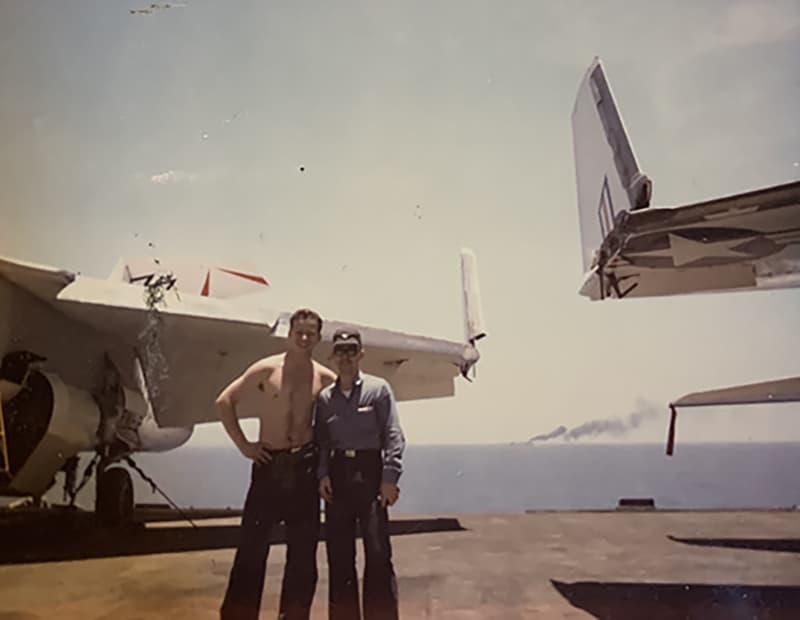330-476-6343 | [email protected]

330-476-6343 | [email protected]

By Leigh Ann Rutledge
Associate Editor
According to an official U.S. Navy website, history.Navy.mil, “within five seconds of the accidental firing of a Zuni 5-inch rocket which slammed into an A-4E Skyhawk (fighter jet) and caught fire Skyhawks on either side of the wounded aircraft were rapidly engulfed by fire.”
This was the beginning of a horrific tragedy July 29, 1967, on the USS Forrestal, a Navy aircraft carrier stationed in the Gulf of Tonkin during the Vietnam War. Hundreds of men were killed and more injured on the ship referred to as the first “super carrier.” The fire spread rapidly as it was fueled by a ruptured 400-gallon fuel tank. As the fire spread, multiple massive explosions occurred.
ADJ3 Alan Jones, a Carrollton resident and Navy veteran, was on the flight deck of the USS Forrestal when the explosion took place. The USS Forrestal had its first strike against the North Vietnamese July 25. July 29 started out as just another day on the ship, the first flight of fighter planes had launched from the ship and the second flight was getting prepared.
Jones worked on aircraft support equipment, large pieces of equipment containing diesel engines. These “power plants” were used to start aircraft. The jet turbines need electric and air to start propulsion.
Jones was near the island, which is the command center for flight-deck operations. A tower formation, it is tall but not wide or long. When the rocket exploded at 10:52 a.m., Jones was knocked off his feet and backwards about 20 feet. After the initial shock, he realized he was not injured and began helping fight the fire.
The fire burned 10 hours. Jones noted the explosions destroyed three levels of the ship and left a hole big enough to set a Cadillac down through.
Jones noted, announcements saying, “This is not a drill” continued during the fire. He also said the ship almost capsized from being rocked by the explosions and smoke could reportedly be seen 10 miles away.
“If it (ship) would have tilted another four degrees, we would have had to abandon ship,” he explained.
The Navy history information site states four aircraft were preparing to launch from the four catapults located on the flight deck.
The site states, “Barely two minutes into the unfolding holocaust the first of many high and low-level detonations erupted as the heat started to cook-off bombs, rockets, and 20-millimeter rounds. An explosion shattered the windows of Primary Flight Control (the island), almost bowling CDR David B. Lember over. Rockets and shells shot across the deck, and ejection seats fired into the air. Seven major explosions shook the ship during the first four minutes of the horrific crisis, and some 40,000-gallons of JP-5 jet fuel from aircraft on deck spread the inferno. Huge clouds of black smoke billowed upward, blinding crewmen racing to battle the flames, which engulfed the fantail and spread to below deck on the 01, 02, and 03 levels, touching off ordnance, trapping some men and wreaking havoc with the crew and ship. Survivors attested to bombs that appeared to be growing red from the heat dropping to the flight deck and blasting holes into the ship. More ruptured fuel tanks spewed volatile jet fuel from beneath aircraft onto the deck, feeding the flames.
Some of the liquid sloshed down into the hanger deck where it posed a deadly hazard for men stationed there. Huge gusts of fire shot into the air along the flight deck, trapping pilots in their aircraft with no recourse but to escape through the flames or be incinerated in their cockpits.”
The pilot of the plane struck by the initial rocket jumped from the plane but was killed when the first bomb exploded.
LCDR John S. McCain III, sitting in Aircraft No. 416 preparing to launch, afterward described the horror:
“I thought my aircraft exploded,” he recounted as the first blast ripped through the aircraft assembled on the flight deck. “Flames were everywhere.”
The young pilot climbed out of his Skyhawk, poised perilously on the A-4C and then leapt through the flames and ran for his life. As he did so the naval aviator saw another pilot jump and roll clear of his aircraft, but the flames caught his uniform ablaze. LCDR McCain turned back to help the man when a bomb exploded and knocked him off his feet and backward about 10 feet. He never saw his shipmate again. The son of the famed pioneering admiral in naval aviation, LCDR McCain would survive being shot down and held as a prisoner of war by the North Vietnamese (1967 through 1973); he eventually received the Distinguished Flying Cross, Silver Star and Purple Heart, and went on to a prominent political career.”
The site describes the chaos, noting a man was seen stumbling around with no clothes on and no skin, men on fire, men blown overboard and some jumping from the flight deck. A sailor noted “a fireball” hurtled toward crewmen, who hit the deck and barely survived as it roared over them.
The accident claimed the lives of 134 men, destroyed around 24 aircraft at a cost in excess of $72 million in damages. The Red Cross notified Jones’ family about a week after the incident that he had not been injured.
Jones doesn’t talk much about that day. He can still see the events unfold and it still bothers him. He knew plane handlers and those who worked on the deck. Personnel on the ship received a 1967 USS Forrestal yearbook, detailing the events of the year, including the fire.
Jones helped fight fire and was also tasked with helping gather the dead. Looking through the pages of the yearbook, Jones said, “It makes me sick. So many below deck were sleeping and died from heat.”
The USS Forrestal was repaired enough to make its way back to the US. Two catapults were still useable on the flight deck and were ready if needed. The ship was put in dry dock at Norfolk, repaired and was in use until it was decommissioned in September 1993. The Forrestal was scrapped in December 2015.
Jones was raised on a farm in Dellroy with four brothers and four sisters and graduated from Carrollton High School in 1965. His father, James F. Jones, Jr., was drafted in the Navy during WWII and served aboard the USS Bon Homme Richard, an aircraft carrier. (His brother the late Edwin C. Jones served in the Marines during Vietnam.)
Knowing the situation when he graduated, Jones had a hard time finding a job. He worked for Rold Gold, a pretzel company for about six months before being drafted into the Army. Instead of going into the Army, he enlisted in the Navy and was sent to Great Lakes Naval Base in Chicago, IL.
In February 1966, he was sent to Norfolk, VA, where the USS Forrestal was dry docked. The USS Forrestal carried 5,500 personnel and four squadrons with 125 aircraft. He was on the ship for a “shakedown” cruise to Cuba before they headed to Vietnam.
The USS Forrestal left Norfolk June 6, 1967, accompanied by tankers and destroyers. The ship made a stop at Rio de Janeiro and personnel were permitted to go sightseeing.
Due to the size of the USS Forrestal, they were required to travel around the Cape of Africa instead of through smaller bodies of water. The Forrestal was the length of three football fields, and when on the water, was nearly half in and half out, with approximately 50-foot above and below water. The water was so rough going around the Cape, the swells were crashing onto the deck.
“It was like a city in its own,” Jones stated, explaining there were two mess halls, sleeping quarters, and an elevator to transport helicopters and fighter jets to the flight deck from storage.
When the Forrestal arrived back at Norfolk Jones transferred to the Norfolk Airbase Helicopter Squadron and was a helicopter mechanic. He remained there until he was honorably discharged in November 1969.
He and his family returned to Ohio where he worked at the Timken Company for a short period and General Telephone for 9½ years. He retired from Carroll Electric Cooperative in 2010, after 31 years of service.
“I thought enlisting in the Navy was a good move. It’s better on a dry ship than wet land,” Jones said. “It was an experience for a young farm boy who thought Atwood was big. I saw flying fish, whales and dolphins.”
When he wears his Navy ballcap, people thank him for his service. He noted by serving on the ship during Vietnam, he was lucky he never had any issues with the public being a Vietnam vet.
After his experience on the Forrestal, Jones still enjoys going to the beach and the water. As for getting on another ship for a cruise, he wasn’t so sure. He did go on the cruise and enjoyed it.
“The mess hall was better,” he chuckled.
Jones and his wife, Chris, reside near Carrollton. They have four children, seven grand- children, four great granddaughters and one great grandson.
Interested in a monthl roundup of stories? Enter your email to be added to our mailing list.
